|
Trades and occupations

The nature of a community can be identified through the occupations pursued by those who work in it but these change with the times. A good example is the transition of blacksmith to motor mechanic because the forge often became the garage as the motor car became popular during the early part of the 20th century. Bourne has had a busy commercial life since mediaeval times but the trades in which its people were involved in centuries past bear little recognition to those we find today and even with those that are similar, their businesses are conducted in a very different fashion.
But what were the main trades carried on here in times past? Agriculture has always been prevalent because the black fen soil is richly productive and so there has always been a predominance of farmers in the locality and this has also attracted the various associated activities through the centuries. The parish registers also indicate that leather workers were prominent during the 16th century, a common feature in Lincolnshire that testifies to the importance of pasture farming for the raising of cattle that provided the hides for the production of leather. Butchers and fellmongers would supply the raw material to the various craftsmen and of the many leather workers in Bourne, the most numerous were the tanners who cleaned and treated the hides, principally those of cattle, but also those of horses, deer, pigs, goats, kids, calves and sheep, before they were passed on to the various craftsmen as leather.
The leading tanners in Bourne in 1560 were John Tomson, Richard Holmes and Robert Prat while a century later the trade was carried on by Robert
Fracey, John Harbye and Robert Shorte. It must have been a reasonably lucrative occupation at that time because when Shorte died in 1649, he left goods worth more than £52, a house with a hall,
parlour, two chambers and a shop in which there were "five hundred of leather, drest and
undrest" worth £9 10s. 0d. and "six and twenty dozen of made wear" worth £6 3s. 0d. Like many tradesmen, he also dealt in other goods and his estate
included a quantity of wool worth £15.
Glovers were another branch of the leather trade in Bourne and during the first half of the 17th century, those engaged in the business included William Marsh, John Homes, John and William White and later Thomas White. When William White died in 1607, he left an estate worth £269, including his farm stock and a large store of leather stacked in his parlour comprising nine dozen various grades of calf leather, 2½ dozen "grained doe skins", 3½ dozen "grained fawn skins", 2 stag skins, 5 hind skins, 3½ dozen "yellow lamb skins", 106 skins of sheep leather and various others including 14 dog skins. There was also a store of wool, this time a considerable stock amounting to 164 tods [a tod being about 28lb.] which was valued at a much higher figure than the leather.
Shoemakers and cobblers were also prominent among the Bourne craftsmen of this period. In the mid 16th century, William Tayleforthe and John Baker were engaged in this trade and a little later John Rowlinson and William Foster. By 1620, the town's shoemakers included John Taylor, John Bradley and William Fracey who is also described as a butcher in the parish registers and so no doubt diversified his business activities with the materials at his disposal. Leather working also extended to
saddlery, a trade carried out by Thomas Trollope who died in 1581.
Many other trades in Bourne were evident at this time such as tailors, butchers and blacksmiths, including one by the name of John Bull who died in 1642. The parish registers of the time also reveal a wide variety of occupations such as bakers, furbishers, watermen, dryers, carpenters, fullers, milliners, fishmongers and clothiers, potters and even a tallow chandler, John
Beacham, who was quite a wealthy man. When he died in 1676, an inventory of his estate indicated that his shop contained stocks of salt as well as candles and that his premises known as the Candlehouse were situated either in or near the market place, an extensive establishment with a warehouse, barn, stable, yard and garden, but by 1770, records indicate that it was being used as a haberdasher's shop by Isaac Halford although it is difficult to determine its exact location in modern Bourne.
The trades and crafts associated with the rural life are amply illustrated in the records of the 18th century. Many people lived and worked in the town such as Thomas
Harby, a miller, who in 1729 took over a windmill that stood in East Field. Thomas Dawkins and William Mason were both tanners at this time but there was also a weaver, John Barker, and a carpenter, John
Bunning, who lived in Westgate, the old name for West Street where Luke Brown, a wheelwright, also worked. There was another wheelwright in Eastgate, Thomas Chambers, and John Brabrook was a mason who worked in Holme End, an area just south of the Abbey Church.
Richard Woulds worked as a currier in Northgate, now North Road, while "in a certain place called the
Watergang" [now South Street] stood the premises of William Shippey, a
whitawer, the name given to someone whose trade was to treat skins and turn them into the fine white leather used for gloves and other fancy items. By the mid-18th century, there was an indication that the Bourne Eau was providing employment because Richard Eldred was working as a boatman. Several inhabitants described themselves as merchants such as Thomas Winpenny and Jeremiah Ives and Daniel Twining who were married to two sisters. John Pare was working as a mercer and draper, John Swift as a glover and Charles Watts as a watchmaker.
|
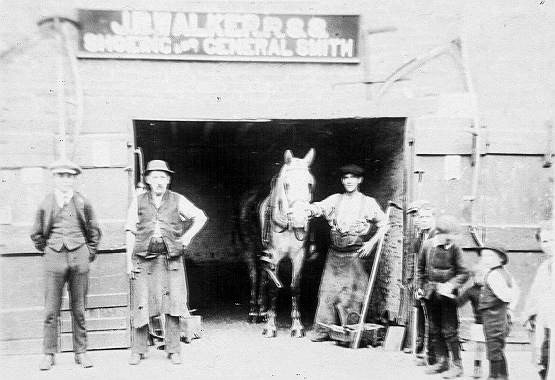 |
|
The widespread use
of horses for transport and agricultural work resulted in a large
number of blacksmiths operating in Bourne in past times. There
were four in the town in 1835 and others opened as the population
increased and they continued to prosper until the arrival of the
motor car in the 20th century when the forges began to give way to
garage workshops.
The
picture above shows the smithy at No 23 Abbey Road run by
Joseph B
Walker who specialised in shoeing horses and general ironwork
and is pictured here circa 1920, second from the left. He was a well-known and popular
personality in Bourne where he lived for 40 years after moving to
the town from Langtoft, working first for Arnold Pick followed by
Messrs Foley Brothers and then Messrs Johnson Brothers before
setting up in business on his own account. He died on Thursday
10th December 1931, aged 74, after a severe attack of pneumonia
aggravated by bronchitis and asthma. The business was then taken over
by Bert Walker, the eldest of his three sons, who was still working there in 1937 together with
three other blacksmiths in Bourne, William Russell of Stocks Yard,
North Street, Henry Collins of Manning Road and Matthew Shipley of
Victoria Place.
Palmer's
saddlery shop at No 3 South Street is pictured below, another
business that depended entirely on the horse, as illustrated by
the accompanying letter heading from 1894. The shop was
originally a 17th century cottage, now a Grade II listed building,
but was then owned and run by Walter Henry Palmer who was in
business as a saddler and harness maker early in the 20th century,
having taken over from his father William Palmer who had been
there since 1856. The photograph shows Walter at the door of the
shop circa 1920 with his wife and son Frances Herbert Palmer who
eventually took over and the business continued until the Second
World War when trade declined because of the popularity of the
motor car. In recent years the shop has been used by Lincolnshire
Bow, the double glazing firm, and is now occupied by Crafty Patch
handicrafts. |
|
 |
|
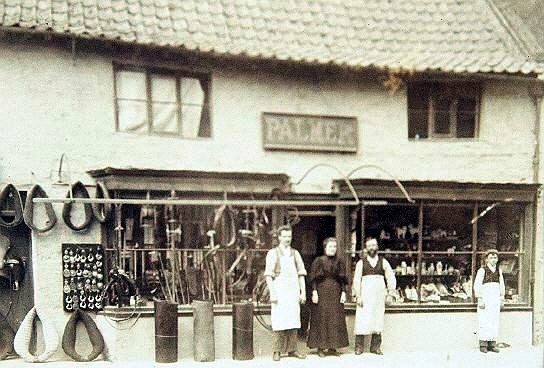 |
Later in the century we find references to John Smith, a cordwainer in North Gate and William
Wyer, a shoemaker in the Watergang. Also working in the town were Robert Osborn, an ironmonger, Thomas Brown, a malster and Edward Rainey, a plumber and glazier while John Gordge was a thatcher and Benjamin Crofts a
slater. Thomas Rawnsley was a wool stapler with premises in South Street opposite what is now the Wellhead Gardens, Augustin
Manby, an apothecary and Thomas Middleton, a surgeon. William Arnold was a flax dresser in Westgate while John Walker, a woodman, worked from premises in Northgate. There were many others but these varied occupations give us a glimpse of the working life in Bourne apart from the farmers or yeomen upon whom the major part of the local economy depended.
One of the earliest indications of the trades pursued in early 19th century Bourne appears in Pigot's 1835 Directory for Lincolnshire that records a large number of businesses devoted to the sale of clothing, listing ten boot and shoe makers, six tailors and drapers, two milliners and dress makers, a glover, a hat maker and three straw hat makers. The town was also supporting eleven grocers, some of them also drapers and tallow chandlers, seven butchers, three millers, five plumbers and glaziers, three surgeons [doctors], four watch and clock makers, four blacksmiths, three saddlers, two wheelwrights, two stone masons and a professor of music.
Victorian England was a place of ingenuity and enterprise and small trades and businesses flourished. We are also able to record this divergence from the various trade and business directories that survive
to give us fascinating details of their occupations. For a great part of the 19th century, Bourne provided a wide variety of goods and services in those days when transport was often inadequate and mass production only just emerging and therefore local craftsmen and producers were able to benefit.
Slater's Directory for Lincolnshire 1857 tells us that in Bourne and Eastgate together, there were 15 boot and shoe makers, 12 bakers and flour dealers, five blacksmiths, seven carpenters and joiners, two wheelwrights and 17 grocers, some of whom were also drapers. A further ten people are listed as tailors and drapers along with ten milliners and dress-makers, five saddlers and harness makers, five hatters, six bricklayers and builders with a further five men described as stone masons, five maltsters and brewers, six butchers, three millers, three ironmongers and two agricultural implement makers. In addition, there was an entire gallery of other occupations and crafts that have now largely died out in small towns such as Bourne. These included two brick and tile makers, two coopers, two leather cutters, two lime-burners (both at Dyke), two rope and sacking makers, two
slaters, two stay-makers, and five straw bonnet makers. Among others listed were a brazier and
tinman, a basket maker, a bird and animal preserver (who in another directory four years later appears as a bird-stuffer and entomologist), a tobacco pipe maker, a leather breeches maker and glover, and a town crier, an office that survived until well into the 20th century when he was still being called out to make public announcements.
|
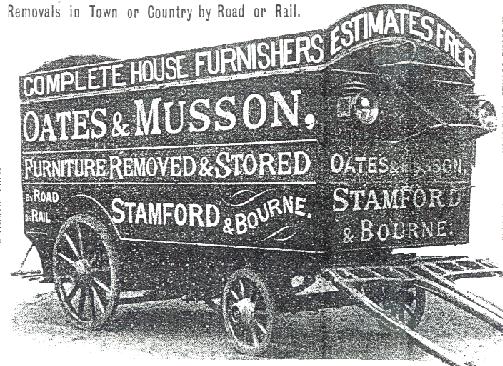 |
|
Oates and Musson were the leading firm of
furniture removers more than a century ago, operating from
premises in North Street now occupied by the HSBC bank. They used
horse-drawn pantechnicons, such as this pictured above that was
taken from a contemporary advertisement, specially designed with a
low line for ease of loading furniture and other domestic effects.
The firm offered: "Complete removals to all parts of the
Kingdom with the greatest care and promptness. Estimates Free.
Ample dry storage for furniture and luggage. Small vans for
removing personal effects. A safe, quick and cheap mode of
removal. Specially constructed for removal without the expense of
packing." |
In later directories we find references to such occupations as horse-breaker, whitesmith, bell hanger and
higgler, an itinerant trader who toured the countryside selling household
wares in exchange for poultry and other dairy products. The term was also frequently used to describe a man who did carting for hire, the description used in a short story by
A E Coppard and this may well have been the occupation of Seth Brown who is listed as a higgler of Eastgate by Kelly's
Directory of Lincolnshire in 1885. There were also several bakehouses in the town including one in "the
Watergang, otherwise Southgate" in 1820 and two others in Eastgate. Later in the century, bakehouses are mentioned in the Austerby [the Old
Bakehouse], at the bottom end of West Street and in North Street.
There was also a thriving brick industry locally during the 19th and 20th centuries because stone was not readily available for house building. Several brickyards were active during this period, employing large numbers of people in the manufacturing process while another local industry is referred to in the manorial documents of 1836 that mention a bleaching ground in Eastgate.
New inventions and the demand for a wider range of goods and services during the 19th century enabled some local tradesmen develop multi-sided businesses offering a variety of wares to the customer. Kelly's in 1905 records that Ernest Foley of Meadow Gate was in business as an agricultural engineer and ironmonger. He was also a cycle, agricultural implement, and stack elevator manufacturer, owner of a threshing machine and traction engine and finally, he was a "shoeing and general smith, and machinery broker". One of his contemporaries was John Morris, who was running a business in West Street that had begun in 1864 and was now housed in a large double-fronted shop with a printing works and show-rooms in the rear, and also comprised a "saloon" for the sale of pianos, organs, and harmoniums.
Kelly's describes Morris's business as ". . . printer, bookseller, bookbinder and stationer, news agent; music seller and circulating library; pianoforte, harmonium and paper-hanging warehouse; and patent medicine vendor and sub-distributor of stamps; and agent for sewing-machines and shipping agent. Post Office". The son of the family, Thomas Morris, not content with merely pursuing the father's many business interests, added photography to the list of services offered by the firm. Unusual occupations were still evident and in 1885, William Redshaw of North Street is listed as a manufacturer of rustic furniture and studio accessories for halls, libraries, drawing and dining rooms, offices, lawns and gardens while William Hodgkin of West Street is described as the vaccination officer for the workhouse and the school attendance officer.
|
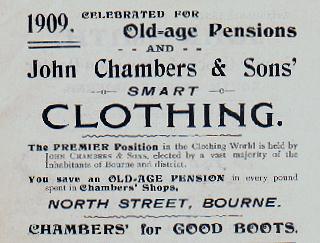 |
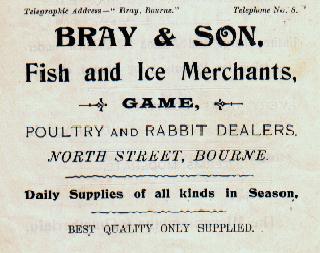 |
|
Trade advertisements
from 1909 as the elderly were beginning to enjoy
an old age pension for the first time. |
|
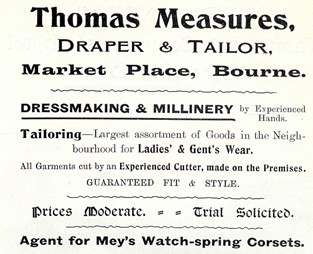 |
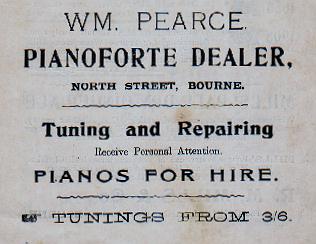 |
The 19th century, with its rising population and trade, also brought an
increase in the number of inns and taverns in Bourne and by the early 20th century, businesses in Bourne were beginning to take on a form more easily
recognisable today and included such trades and professions as solicitors, grocers, hairdressers, coal merchants, dentists, boot repairers, gents' outfitters, bakers, fishmongers, painters and milliners although there were still the unusual occupations by today's standards.
In 1913, Kelly's recorded that William Adams of the Austerby was working as a cowkeeper, Mrs Eliza Blades of Eastgate earned a living as a wardrobe dealer, the Misses Mary and Rose Browning were running a Berlin wool repository in North Street and William Richardson of West Street was described as a
tinman. There was also a horse slaughterer, shoeing smith, basket maker, monumental mason, rope manufacturer and costumier while Richard Lloyd of Eastgate was employed as the Town Crier, an office that was to become defunct later in the century.
|
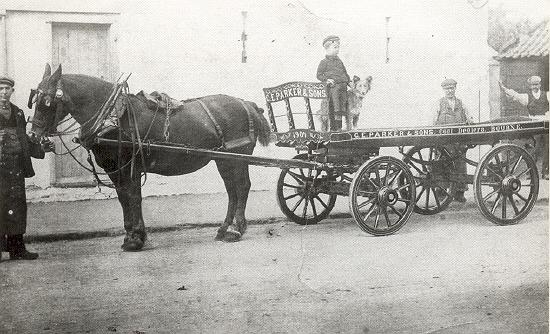 |
|
A new horse draw cart delivered to G E Parker &
Sons of 16 Abbey Road, Bourne, circa 1930. The firm of corn and
flour dealers was established by George Ellis Parker in 1907 but the
name changed when his sons entered the business and the arrival of a
new coloured cart was always cause for celebration. |
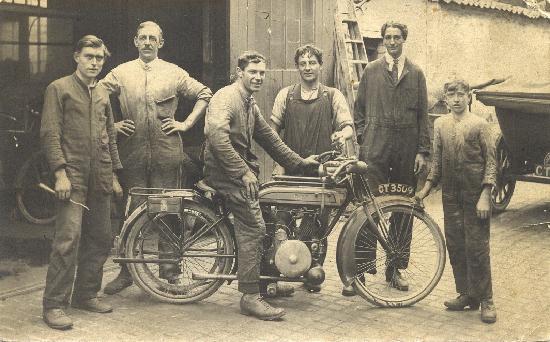
There was also an emerging industry in the
sale and servicing of motor cycles and motor cars and one of the
forerunners in this was Station Garage run by Tuck Brothers in South
Street where the photograph above was taken circa 1930. It shows the
garage staff with a Clynomaster motor cycle model CT 3509 with Saville
Turner on the extreme left. The garage premises were on the site of the
stone gateway leading into the grounds of the Red Hall which was
demolished in 1918 by German prisoners of war from camps in the locality
to make way for the new development.
Tuck Brothers described themselves as
"Motor and Electrical Engineers" and agents for Austin and Morris cars. A
contemporary advertisement advised: "Repairs a speciality, tyres and spare
parts always in stock, welding plant and accumulators charged", the latter
service being devoted to the wet batteries used for the wireless sets of
the day which needed regular recharging. The garage also had a showroom
for motor cycles, cycles and accessories in North Street.
|
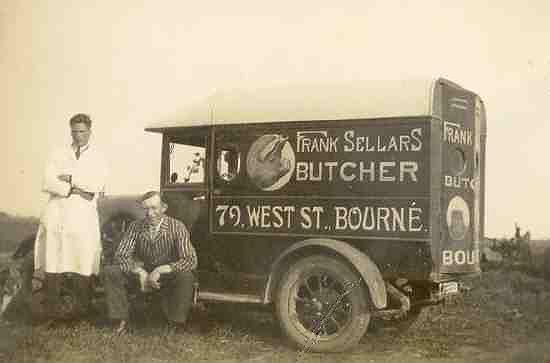 |
|
Frank Sellars, butcher, of 79 West Street,
Bourne (seated) with his assistant Wilfred Ball, photographed above
on their rounds, circa 1933, and below, the owner of J G Mayfield
and Company, pork butchers, of 5 West Street, Bourne, photographed
circa 1937, with one of his delivery boys. |
|
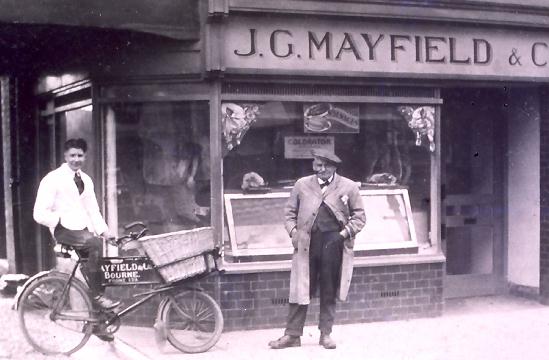 |
|
 |
|
Herbert Atkin with his wife and two children outside their
clothing shop
at No 14 North Street circa 1930. |
|
Commercial
directories of the 19th century are a particular source of
information about the trades and occupations of past times. This
is a complete list for Bourne in 1835 compiled from Pigot's
Commercial Directory for Lincolnshire published in that year. |
Academies and schools:
Cyril Leake, Eastgate
Ann Moore, Star Lane
National School, North Street
Catherine Osborn, West Street
Richard Woulds, West Street
Attorneys:
William David Bell, West Street
William Worth, North Street
Bakers and flour dealers:
James Greenwood, West Street
Edward Halford, Star Lane
Robert Nichols Munton, North Street
Thomas Smith, West Street
William Williamson, South Street
Bankers:
Peacock, Handleys' and Peacock, South Street
Basket makers:
Thomas Tabor, West Street
William Ward, North Street
Blacksmiths:
Abraham Davis, North Street
William Spreckley, North Street
George Templeman, North Street
Thomas Tye, Star Lane
Bookseller, stationer and printer:
William Daniell, Market Place
Boot and shoe makers:
James Barfield (dealer), North Street
William Brinkley, West Street
Thomas Carrott, North Street
James Gibbins, North Street
John Horne, West Street
George Lenton, West Street
Francis Smith, West Street
William Stubley, Eastgate
William Swift, North Street
Thomas White, West Street
Braziers and tin-plate workers:
David Beedzler, North Street
Henry Cunnington, West Street
Bricklayers and builders:
John Clarke, West Street
John Hinson, Eastgate
John Longland, West Street
Butchers:
Benjamin Binns, West Street
Charles Clark, North Street
John Hardwick, North Street
William Hardwick, Star Lane
John Lenton, Market Place
Mary Lenton, Market Place
Thomas Shipley, Star Lane
Carpenters and builders:
William Evans, West Street
Henry Richardson, Eastgate
William Smith, North Street
John Walker, West Street
Chemists and druggists:
William Mullett, Market Place
William Henry Phillips, North Street
William Swift, North Street
Coal merchants:
James Carter, Eastgate
Clifton, Thompson & Co., Eastgate
Robert Nicholls Munton, North Street
Confectioners:
Ann Eggleston, North Street
Jane Gillison, West Street
Coopers:
John Boyer, West Street
Robert Timson, Star Lane
Curriers & leather cutters:
Edward Phipps, West Street
Francis Smith, (leather cutter), West Street
Fire and office agents:
County (fire) & Provident (life) - John Osborn, Market Place
Norwich Union - Wherry & Sons, North Street
Sun - William Daniell, Market Place
Gardeners and seedsmen:
Charles Christopher, West Street
William Shipley, Star Lane |
Hair dressers:
Thomas Carpenter, East Street
William Flintoft, South Street
Gatliffe Towns, Market Place
Inns:
Angel, Henry Bott, Market Place
Bull, (commercial & posting) William Layton, Market Place
Ironmongers:
Abraham Davis, North Street
Charles Osborn, Market Place
Malsters:
Clifton, Thompson & Co., West Street
Robert Nicholls Munton, North Street
Millers:
Robert Nicholls Munton, North Street
Joshua Page, Eastgate
Thomas Smith, West Street
Milliners & dress makers:
Mary King, South Street
Mrs. William Todd, Market Place
Painters - house & sign:
Joseph Fish, West Street
James Handley, West Street
Plumbers & glaziers:
William Banks, North Street
John Eggleston, North Street
Joseph Gentle, North Street
Robert Sutton, North Street
John Waters, North Street
Rope & sacking manufacturers:
Michael Little, West Street
Thomas Pridman, North Street
Saddlers:
Thomas Redshaw, North Street
Thomas Shippey, Market Place
Thomas Worship, Star Lane
Stone Masons:
John Hinson, Eastgate
Robert M Pattinson (& bricklayer), Star Lane
Straw hat makers:
Mary Bray, West Street
Mary King, South Street
Mrs. Todd, Market Place
Surgeons:
Robert Beecham, Market Place
Francis Bellingham, Market Place
George Nicholls, South Street
Tailors & drapers:
Charles Collins, West Street
Henry Parker, Star Lane
Phillips & Ellis, North Street
Henry Phillips, Eastgate
William Todd, Market Place
George Wiles, Eastgate
Tanners & fellmongers:
George Bettison, West Street
James Lee Row (fellmonger), Eastgate
Taverns & public houses:
Anchor (Thomas Wilcox), Eastgate
Horse & Groom (Jonathan Veasey), West Street
King's Head (Mary Shipley), Eastgate
Marquis of Granby (Ednott Ley), East Street
Masons' Arms (Sarah Smith), South Street
Nag's Head (Edward Key), Market Place
New Inn (James Carter), Eastgate
Red Lion (John Gatliffe), South Street
Royal Oak (William Bonner), North Street
Six Bells (Robert Bull), North Street
Windmill (Mary Banks), North Street
Watch & clock makers:
Abraham Hopkin, West Street
William Sharpe (and silversmith), South Street
John Wilson, West Street
Thomas Wilson (and silversmith), North Street
Wheelwrights:
John Morris, West Street
John Woolley, North Street
Wine & spirit merchants:
Clark Michael Callow (spirit), West Street
John Clifton (& timber), West Street
Woolstaplers:
John Mawby, South Street
James Lee Row, Eastgate
|
REVISED FEBRUARY 2015
See also
Early closing in Bourne Trade notices
The loss of our small shops

Go to:
Main Index Villages
Index
|











